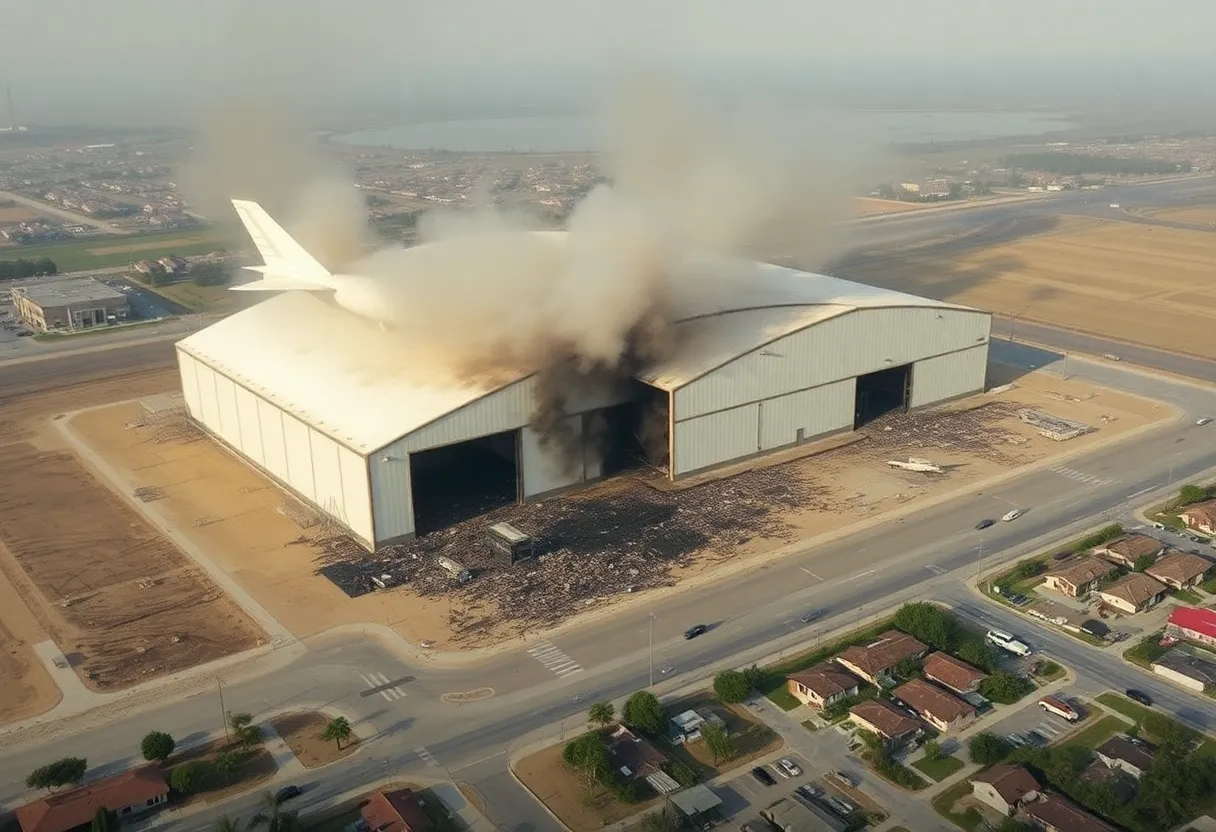News Summary
The Tustin community is in distress following the discovery of asbestos in debris from a historic fire at a blimp hangar, prompting widespread school closures and health concerns.
Asbestos Alarms After Tustin Historic Fire: A Community on Edge
In a shocking chain of events, the debris and ash resulting from a devastating fire at a historical blimp hangar, located at the former Tustin Air Force Base, has tested positive for asbestos. According to a recent report by the South Coast Air Quality Management District, levels of asbestos present in the remnants from the blaze have raised serious concerns in the local community, as the presence of this hazardous material is well-known to be linked to various forms of cancer, including the deadly disease mesothelioma.
Impacts on Local Institutions and Public Health
The aftermath of the fire has forced the Tustin Unified School District to shut down all schools, daycares, preschools, and parks shortly after it ignited earlier this week. The closures were compounded by air quality worries, prompting immediate action by school officials. They postponed all activities and classes, highlighting the safety of students and staff as a top priority. With Veterans Day falling on Friday, students were already scheduled to remain home, extending concerns into the weekend.
In a proactive measure following air testing results that indicated debris contained greater than 1% asbestos, city officials also advised residents to limit outdoor exposure. Investigations revealed that schools closest to the fire, such as Heritage Elementary and Legacy Magnet Academy, showed no signs of asbestos in air and dust samples, providing some relief amidst the chaos.
Unearthing the Truth: Further Investigations and Atmospheric Safety
A follow-up examination by public health officials took a closer look at 50 homes in proximity to the hangar. Fortunately, there were no findings of lead or asbestos attributable to the fire, although one residence did test positive for elevated lead levels in indoor dust samples—none of which could be linked to the catastrophic event.
Despite these assurances, anxiety prevails in the Tustin community. Many residents are understandably fearful, with some expressing feelings of terror when stepping outdoors, concerned about potential asbestos exposure. The ongoing cleanup is complicated due to the long-term health risks associated with asbestos, as diseases like mesothelioma often don’t manifest for years following exposure.
Community Response and Cleanup Efforts
To combat the fallout from this fire, local officials have been quick in their response. The city of Tustin has dedicated a staggering $87 million for fire response efforts, primarily focusing on debris clearance and stabilization of ash fallout around the hangar site. Meanwhile, the Navy, responsible for the property, has pledged to repay $61 million of those costs.
Despite the financial commitments and ongoing cleanup operations, local residents remain in the dark about the risks associated with asbestos exposure. Mixed messages from officials about the safety and health risks posed by asbestos only serve to compound existing fears among families. Residents are demanding more thorough testing and clearer communication to ensure safety, with calls for national emergency designation being made to secure additional funding and support.
Looking Ahead: Monitoring, Litigation, and Accountability
As the cleanup continues with Navy contractors diligently dismantling remaining structures and monitoring air quality, local leaders are gearing up for potential litigation concerning health impacts and property damage stemming from the fire. The consensus is clear—the community desires vigilant monitoring throughout the cleanup process to avert further complications and health risks.
As the Tustin hangar fire investigation develops, the community remains in a state of uncertainty. With ongoing cleanup expected to last up to 12 months, the need for local government accountability and support has never been more crucial. The situation starkly illustrates the ongoing dangers posed by asbestos in older structures, emphasizing a collective need for awareness about the potential health risks that linger long after the flames have been extinguished.
Deeper Dive: News & Info About This Topic
HERE Resources
Asbestos Abatement Project brings new life to the Crim Theater
New Research Project in Clydebank Aims to Unravel Mesothelioma
New Support Group in Cwmbran for Mesothelioma and Lung Cancer Patients
Researchers Unveil Promising Breath Test for Early Detection of Mesothelioma
Study Aims to Unravel the Mystery of Mesothelioma’s Long Latency Period
The Smith Family’s Heartfelt Tribute: A Coffee Company in Memory of a Beloved Son
Homelessness Crisis Grew as Sewage Repairs Delayed in London
Asbestos Awareness Training: A Growing Concern for Apprentices
Deadly Asbestos Allegations Rock Scottish Building Sector
Community Outrage Follows Asbestos Mishandling in Southwark Housing Crisis



















